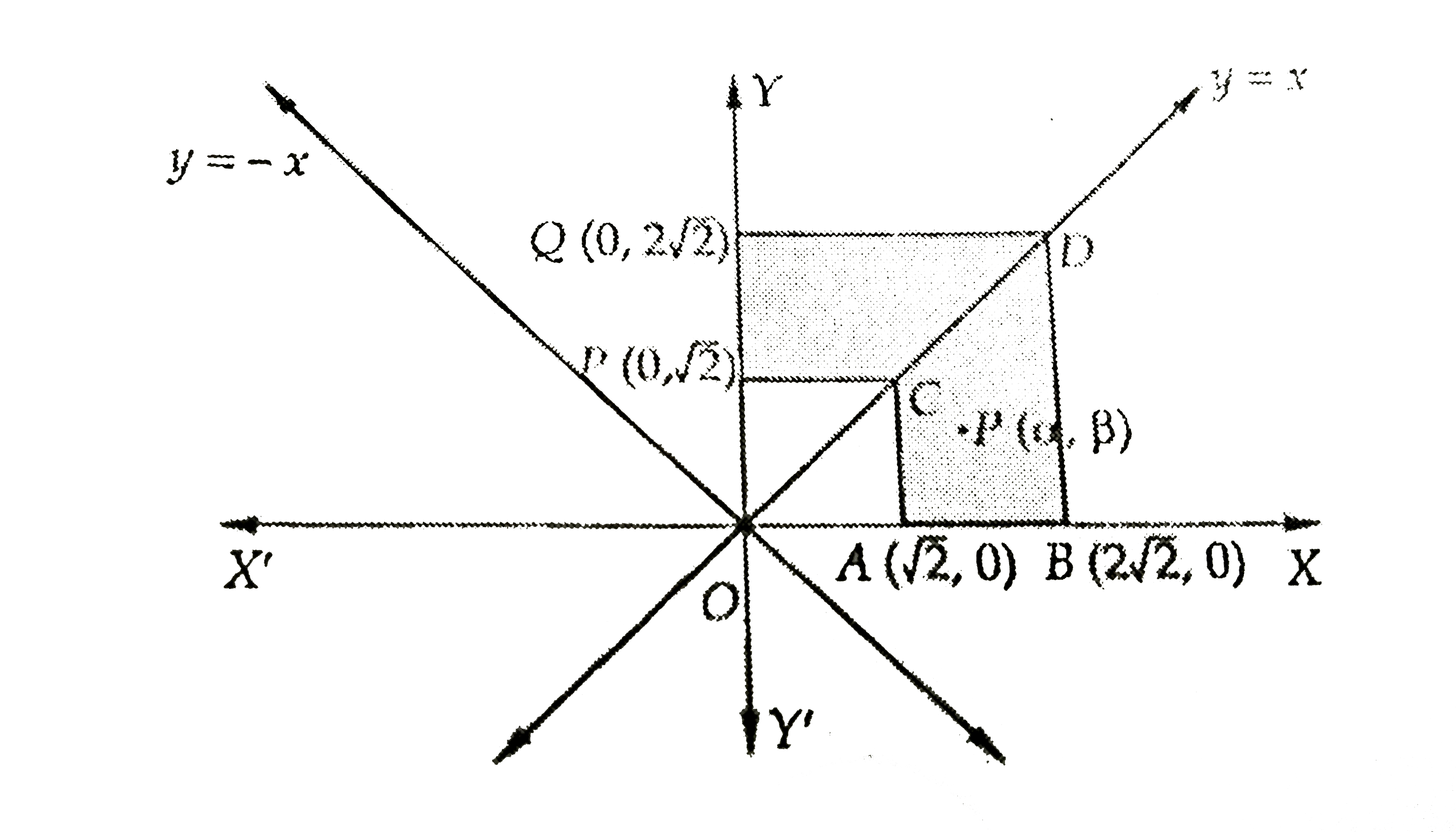For a point P in the plane, let d1(P)andd2(P) be the distances of the point P from the lines x−y=0andx+y=0 respectively. The area of the region R consisting of all points P lying in the first quadrant of the plane and satisfying 2≤d1(P)+d2(P)≤4, is
4 sq.units
6 units
8 sq. units
2 sq. units
The correct Answer is:B
Let P (α,β) be a point in the first quadrant . Then two cases arise .
CASE I When P lies in the region satisfying y≤x :
In this case , β≤α
So , d1(P)+d2(P)=|α−β|√2+|α+β|√2
= α−β√2+α+β√2=2α√2=√2α
∴2≤d1(P)+d2(P)≤4⇒2≤√2α≤4⇒√2≤α≤2√2...(i)

CASE II When P lies in the region satisfying y≥x :
In this case , we have β≥α.
So , d1(P)+d2(P)=|α−β|√2+|α+β|√2=β−α√2+α+β√2=√2β
∴2≤d1(P)+d2(P)≤4⇒2≤√2β≤4⇒√2≤β≤2√2 ... (ii)
The shaded region shown in fig satisfies (i) and (ii) . So , region R is the shaded region in Fig.
Area of region R = Area of square OBDQ - Area of square OACP
=(2√2)2−(√2)2=6sq. units
Hence , the locus of Q is (x−1)2+(y−2)2=(√2)2 which is a circle of radius √2 .
Topper's Solved these Questions
- STRAIGHT LINESBOOK - OBJECTIVE RD SHARMA ENGLISHCHAPTER - STRAIGHT LINESEXERCISE - Section-1 Solved MCQs (Example)
1 Videos
- STRAIGHT LINESBOOK - OBJECTIVE RD SHARMA ENGLISHCHAPTER - STRAIGHT LINESEXERCISE - SECTION - II (ASSERTION - REASON TYPE MCQs)
14 Videos
- STRAIGHT LINESBOOK - OBJECTIVE RD SHARMA ENGLISHCHAPTER - STRAIGHT LINESEXERCISE - ILLUSTRATION 18
1 Videos
- SETSBOOK - OBJECTIVE RD SHARMA ENGLISHCHAPTER - SETSEXERCISE - Chapter Test
30 Videos
Similar Questions
Plot the region of the points P (x,y) satisfying |x|+|y|<1.
View SolutionConsider a rectangle ABCD formed by the points A=(0,0), B= (6, 0), C =(6, 4) and D =(0,4), P (x, y) is a moving interior point of the rectangle, moving in such a way that d(P,AB)≤min{d(P,BC),d(P,CD)andd(P,AD)} here d (P, AB), d (P, BC), d (P, CD) and d (P, AD) represent the distance of the point P from the sides AB, BC, CD and AD respectively. Area of the region representing all possible positions of the point P is equal to (a) 8 sq. units (b) 4 sq. units (c) 12 sq. units (d) 6 sq. units
View SolutionFind the distance of the point P(−1,−5,−10) from the point of intersection of the line joining the points A(2,−1,2)andB(5,3,4) with the plane x−y+z=5.
View SolutionLet P be the set of points (x,y) such that x2≤y≤–2x+3. Then area of region bounded by points in set P is
View SolutionLet P be the image of the point (3,1,7) with respect to the plane x−y+z=3. Then, the equation of the plane passing through P and containing the straight line x1=y2=z1 is
View SolutionIf P is any point on the plane lx+my+nz=pandQ is a point on the line OP such that OP.OQ=p2 , then find the locus of the point Q.
View SolutionLet (x,y) be any point on the parabola y2=4x. Let P be the point that divides the line segment from (0,0) and (x,y) n the ratio 1:3. Then the locus of P is :
View SolutionLet (x,y) be any point on the parabola y2=4x. Let P be the point that divides the line segment from (0,0) and (x,y) n the ratio 1:3. Then the locus of P is :
View SolutionIf P is any point on the plane lx+my+nz=pandQ is a point on the line OP such that OP.OQ=p2 , then find the locus of the point Q.
View SolutionLet there are three points A(0,43),B(–1,0) and C(1,0) in x – y plane. The distance from a variable point P to the line BC is the geometic mean of the distances from this point to lines AB and AC then locus of P can be
View Solution
